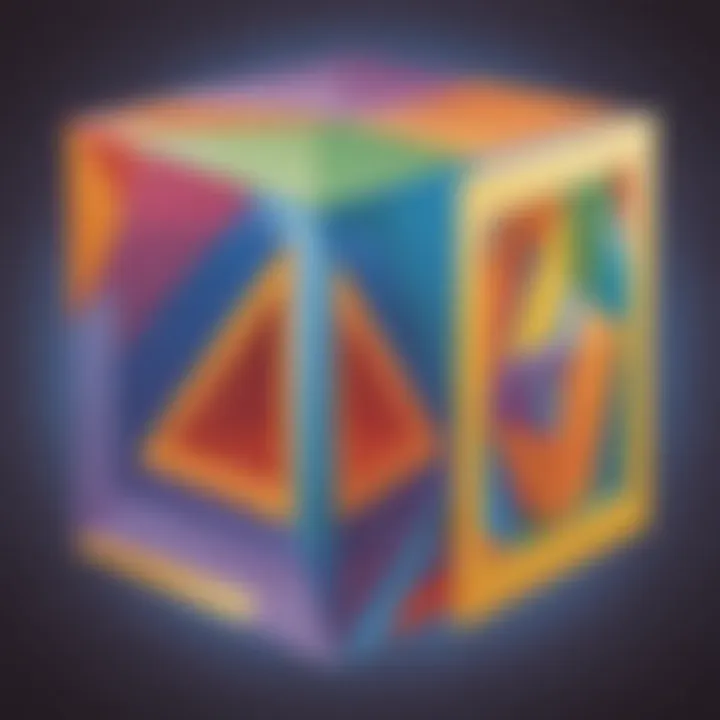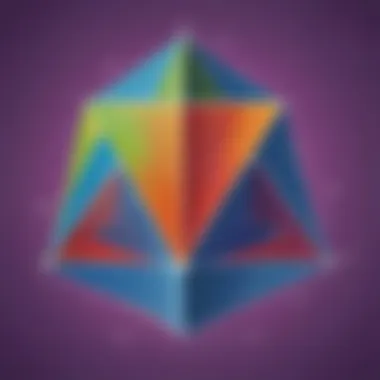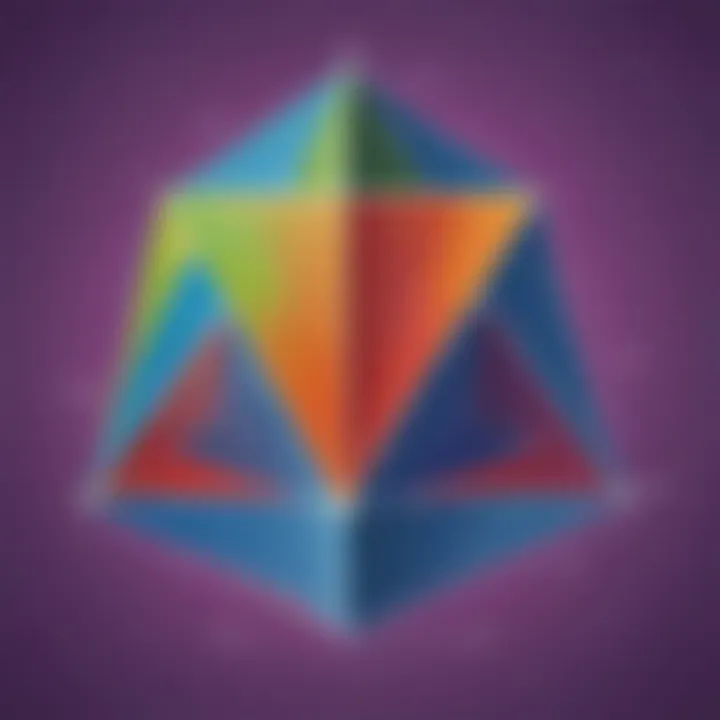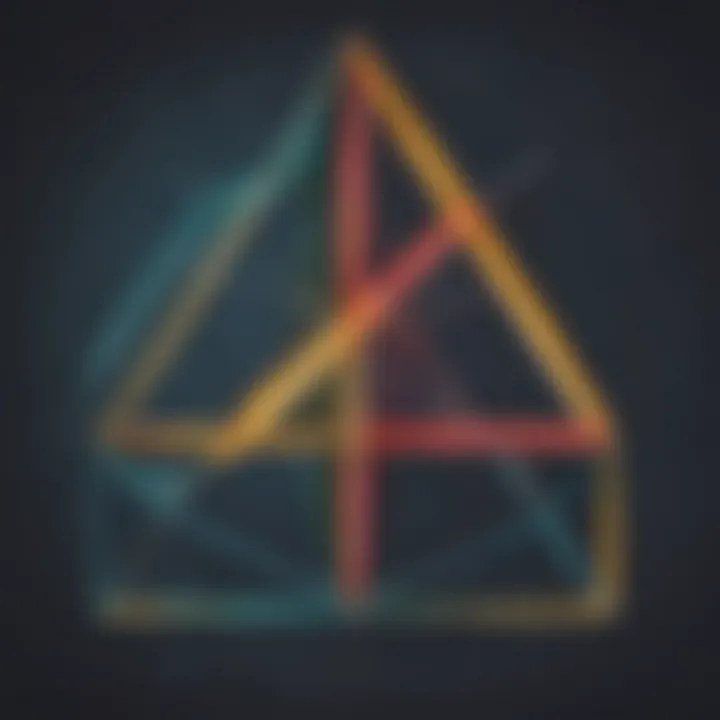A Beginner's Journey Through the World of Geometry


Intro
Geometry is one of the foundational branches of mathematics. Understanding its essential principles opens numerous paths for learners. Geometry is not just about angles, lines, and shapes; it anchors our comprehension of space and our ability to visualize and solve real-world problems.
During this journey into geometry, beginners will encounter a variety of crucial concepts. Key terminology will also be introduced, forming the core vocabulary needed for progressive understanding. We hope to make the subject approachable, revealing its practical applications in everyday life.
In addition, the article cuts through complex theories and provides solid learning strategies for young learners. Our aim is to create a solid base for understanding, ensuring that novice students can grasp and appreciate geometry with ease.
Creative Activities
Engaging with geometric concepts through creative activities aids in comprehension and retention. Such activities appeal to the student's imagination while incorporating practical application.
Craft Ideas
Children can craft simple models of geometric shapes. They can use cardboard or colored paper to create shapes like triangles, squares, and even complex polyhedra. These hands-on projects help to visualize geometry in a meaningful way.
Step-by-Step Guides
- Creating a Triangle
- Making a Cube
- Cut three equal lengths of string.
- Join the ends to form a triangle.
- Now, color each side with markers.
- Cut out six square pieces of paper.
- Fold each piece along the edges stapling them as you go.
- Assemble them together to form a cube.
Educational Value
Participating in these activities on geometry encourages spatial reasoning. This is vital for young learners, as it helps in cognitive development and reinforces geometry principles. When kids can touch and build shapes, they find it easier to understand how these shapes interact in the wider world.
Fun Quizzes
After practicing with geometric shapes, quizzes create an interactive experience.
Quiz Topics
Students can expect to see topics on basic shapes, properties of angles, and spatial relationships in the quizzes. Each topic challenges their knowledge and their growth.
Question Types
- Multiple Choice
- True or False
- Fill in the Blanks
These different formats ensure that learning remains dynamic and engaging, enhancing overall retention of geometric concepts.
Knowledge Reinforcement
Using quizzes to solidify understanding builds confidence in learners. The feedback from quizzes can also identify areas that need more focus.
Fact-Based Articles
For expansive learning, fact-based articles provide valuable insights into geometry, which complements interactive activities.
Topics
Diverse articles discuss subjects such as geometric transformations, history of geometry, and famous mathematicians who contributed to the field.
Engaging Content
These articles are written in straightforward language, making complex information digestible. Diagrams and visuals further enhance understanding by breaking down concepts.
Preamble to Geometry
Geometry serves as a foundational aspect of mathematics and is essential for a variety of fields such as art, engineering, and computer science. This section aims to introduce the subject and highlight its necessity for basic numeracy skills, critical thinking, and real-world applications.
Understanding the Basics of Geometry
At its core, geometry is the study of shapes, sizes, and the properties of space. It begins with fundamental concepts including points, lines, angles, and surfaces. Familiarity with these concepts enables individuals to visualize the physical world more effectively. For example, when working with blueprints or maps, knowing how to interpret these basic geometric objects is crucial.
Here are some important elements to consider when leaning the basics:
- Points are the simplest units in geometry and signify a location in space.
- Lines are straight objects extending infinitely in both directions, defined by two points.
- Planes are flat surfaces that extend in two dimensions without end.
- Angles arise when two lines intersect and are measured in degrees.
Incorporating these elements into one’s understanding presents a clearer comprehension of how they fit into more complex topics in geometry.
Importance of Geometry in Everyday Life


Geometry is not just an abstract concept; it plays a pivotal role in everyday life. From calculating the amount of paint needed for a room to designing structures such as bridges and buildings, an understanding of geometry is vital.
It influences a variety of practical scenarios:
- Architecture: Builders and architects use geometry to create safe and functional structures.
- Technology: Engineers apply geometric principles in product design and coding algorithms.
- Art: Artists utilize geometric shapes and proportions to create visually appealing pieces.
The implications of geometry in everyday tasks highlight its importance beyond academic applications.
(## Core Concepts of Geometry
Core concepts in geometry form the essential language of this discipline. They provide a solid foundation which allows learners to progress with confidence. Understanding these concepts is not just about memorizing definitions; it involves grasping the interrelations they have within the wider context of math and its applications in real life. Mastery of these ideas means being capable of approaching complex problems with more meaningful understanding and insight.
Defining Points, Lines, and Planes
Points, lines, and planes lay the groundwork of geometric principles. A point is an exact location in space without dimensions, making it a basic builder of geometrical figures. Lines can extend infinitely in both directions, demonstrating direction through their positive and negative ends, essential for graphing and coordinate systems. A plane is a flat surface where any two points can be connected by a line lying wholly on that surface. Together, these components serve as a framework from which other geometric shapes, and more complicated concepts, can be formed.
Exploring Angles and their Classifications
Angles represent the amount of rotation between two lines meeting at a common point. They are critical in determining relationships among shapes and realizing designs in both architectural and mechanical fields. Angles are classified into distinct groups such as acute, obtuse, and right angles, each possessing unique properties that are pivotal in both theoretical and applied geometry. By studying various types of angles, learners gather skills crucial for advanced geometric calculations and daily problem-solving scenarios.
Understanding Shapes: Polygons and Circles
Understanding shapes is vital as they serve as visual representations of many geometrical concepts. Two fundamental categories are polygons, which have straight sides, and circles, which consist of curved lines.
Characteristics of Polygons
Polygons are defined by the number of sides and their lengths. A polygon's characteristic determines its classification, be it a triangle, rectangle, pentagon, or other forms. The simplest polygon is a triangle, comprising three sides. Importantly, the sum of internal angles increases with more sides, offering insights about the shapes' visual attributes. This progressive increase in angles gives polygons diverse traits, making them worth studying for various professional applications. Understanding polygons not only sharpens basic geometric skills but prepares learners for understanding complex shapes used in fields such as graphic design, architecture, and animation.
Properties of Circles
Circles are unique shapes characterized by curves, defined as the set of all points equidistant from a central point. A circle's properties, including circumference and area, create fundamental learning opportunities for beginners. Its symmetries and relationships serve as a counterpoint to the deficiencies posed by polygons. When dealing with pi, which uncovers beautiful calculations linked to circles, students engage deeply with both theoretical concepts and practical applications. Understanding these properties consolidates the foundational elements to help students excel in future geometry learning.
Understanding categories like polygons and circles not only group shapes and angles in manageable ways but serves as a bridge to dimensions, calculations, and intricate figures that inspire mathematic exploration.
As students work through these concepts, they earn critical skills vital not only for future studies in mathematics but for engaging with architectural designs and engineering principles. Recognizing and evaluating how geometric formulas translate into real-world applications becomes a gateway for creative thought and logical reasoning.
Measuring Geometric Figures
Measuring geometric figures is a cornerstone of understanding geometry. It enables us to quantify the characteristics of various shapes, giving them practical significance in both academic contexts and real-world applications. By learning how to measure area, perimeter, volume, and surface area, beginners equip themselves with skills beneficial for advanced mathematics, science, engineering, and everyday tasks like decoration or construction.
Calculating Area and Perimeter
Area and perimeter are fundamental concepts in geometry.
Area refers to the amount of space inside a shape. For simple shapes like squares and rectangles, finding area is straightforward:
- For squares, multiply the length of one side by itself (Area = side × side).
- For rectangles, multiply the length by the width (Area = length × width).
- For circles, the formula is π times the square of the radius (Area = πr²).
Calculating the area of a shape can reveal information about its capacity in materials, floor plans, and more.
Perimeter, conversely, is the total distance around the shape. To find the perimeter:
- For squares, add the lengths of all four sides (Perimeter = 4 × side).
- For rectangles, add the lengths of all sides (Perimeter = 2 × (length + width)).
- For circles, use the formula (Perimeter = 2πr) to find the circumference.
Understanding both area and perimeter can greatly impact tasks such as tailors cutting fabric or painters determining paint needed for a wall.
Understanding Volume and Surface Area
Volume and surface area extend the concept of measurement into three dimensions.
Volume measures how much space an object occupies. For beginners, focus is typically on basic solids:
- For cubes, it is calculated as Volume = side³.
- For rectangular prisms, the formula used is Volume = length × width × height.
- With cylinders, it's Volume = πr²h.
This information is essential in fields like shipping, where knowing how much cargo fits in a container can affect costs.
Surface Area, meanwhile, quantifies the total area that the surface of an object occupies. Important formulas include:
- For cubes, Surface Area = 6 × (side × side).
- For rectangular prisms, Surface Area = 2(lw + lh + wh).
- For cylinders, Surface Area = 2πr(r + h).
Being familiar with both volume and surface area increases comprehension when tackling real-world problems, such as packaging or construction.
Mastering area, perimeter, volume, and surface area leads to clearer discussions and decisions in geometry.


Geometric Transformations
Geometric transformations play a pivotal role in geometry and are essential for understanding how shapes can change positions or sizes within a space. They lay the groundwork for more complex geometric concepts, making it easier for beginners to visualize and grasp the flexible nature of geometry. By learning about transformations, students develop their spatial reasoning skills, which are crucial for success in a variety of real-world applications.
Understanding transformations also benefits students in several ways. First, it cements the idea that geometric shapes are not static, encouraging creative thinking and problem-solving. Second, transformations establish connections among various mathematical concepts, furthering comprehension in other areas like algebra. Lastly, they serve practical applications in fields such as art and architecture, fostering appreciation for geometric design.
Intro to Transformations
Transformations in geometry allow us to modify geometric figures in specific ways. A transformation can result in a figure being moved, resized, or flipped, creating a new version of the original shape. The objective is to maintain certain properties, like length and angles, while altering the positioning or form of the shape.
Common Types of Transformations
- Translation: moves a shape without altering its size or orientation. Each point in the shape shifts a certain distance in a specific direction.
- Rotation: spins a figure around a designated point, known as the center of rotation. It changes the orientation but keeps the shape intact and merely alters where it sits on the coordinate plane.
- Reflection: flips a figure over a line known as the line of reflection. This transformation creates a symmetric image of the original shape.
- Dilation: adjusts the size of a shape based on a scale factor, either enlarging or reducing it, while keeping the same shape. This transformation affects the dimensions but retains the proportionality.
Types of Transformations: Translation, Rotation, Reflection, and Dilation
Understanding these four key transformations is fundamental in both geometry and real-world applications.
Key Takeaway: Transformations impart a dynamic quality to geometric figures, letting students imagine how objects can interact within a space.
1.
Translation When translating a shape, you move it from one location in a plane to another without adjusting its size or orientation. Think of a square being scooted across a table; it remains unchanged in form as it shifts positions.
2.
Rotation To rotate a shape, envision turning it around a particular point. For instance, rotating a triangle around a selected vertex allows for an understanding of angles and symmetry. The angle of rotation determines how far the shape turns.
3.
Reflection Reflecting a shape exemplifies symmetry. A shape, like a butterfly for example, reflects into its image along a mirror line. This stretching of space shows how reflection creates visually balanced designs.
4.
Dilation When dilating an image, enlarge or shrink it without deforming its structure. A circle can grow larger or smaller while retaining its round shape, emphasizing stability. Using a scale factor provides clarity during this process.
Incorporating geometric transformations into lessons enables students to understand the flexibility of shapes in space and fosters a stronger grasp of advanced geometric principles.
Basic Theorems in Geometry
Understanding basic theorems in geometry is crucial for anyone embarking on a journey to learn this subject. Theorems provide foundational principles that not only allow for deeper understanding but also serve as building blocks for more advanced concepts. They provide us with rules and formulas that can be applied in architecture, engineering, and other relevant fields, making them highly applicable in real life.
Mathematics relies heavily on theorems to provide clarity and certainty. In geometry, theorems connect various geometric figures and notions, showing how they interrelate. Consequently, knowing these basic rules facilitates easier problem-solving and computation as students progress in their studies.
Understanding the Pythagorean Theorem
The Pythagorean Theorem, a fundamental principle in geometry, connects the sides of a right triangle. This theorem states that in a right triangle, the square of the hypotenuse's length is equal to the sum of the squares of the lengths of the other two sides. It is mathematically represented as:
c² = a² + b²
where:
- c is the length of the hypotenuse
- a and b are the lengths of the other two sides.
This theorem is not just a theoretical concept; it has practical applications in various fields, such as construction and navigation. Understanding the Pythagorean theorem helps students see relationships in geometry.
Students can employ this theorem to calculate the length of a side in a right triangle. As they practice, they will discover that it can be used in solving various problems. Thus, encouraging an in-depth understanding leads to more confidence in tackling geometry-related queries.
Theorems Related to Angles
Several important theorems concern angles, offering insights into their relationships and properties. Familiarity with these theorems is essential for mastering geometry concepts. Key theorems on angles include the following:
- Vertical Angles Theorem: When two lines intersect, the angles opposite each other are equal. This property is useful when simplifying problems involving intersecting lines.
- Complementary Angles: Two angles are said to be complementary if their sum equals 90 degrees. This can help in finding unknown angles as they work well in various real-world problems.
- Supplementary Angles: A pair of angles is supplementary when their sum is 180 degrees. Knowing this allows for an easier understanding of angle relationships in linear pair problems.
- Angle-Angle Similarity Theorem: This theorem states that if two angles of one triangle are equal to two angles of another triangle, the triangles are similar. Recognizing similar triangles has applications in various real-life scenarios, including design and measurement.
In summary, these theorems related to angles enhance comprehension and proficiency in geometry. They serve not only to connect different geometrical principles but also to facilitate problem-solving for learners.
The knowledge of basic theorems is indispensable in geometry, as they pave the way for a broader understanding of the subject and support practical application in real-life scenarios.
Applications of Geometry
Geometry holds significant relevance across various fields, demonstrating its incredibly practical applications. Understanding how geometry is embedded in different sectors helps learners grasp not only the concepts but also their usefulness. This section will highlight two major applications: Architecture and Engineering.
Geometry in Architecture
Architecture relies profoundly on geometric principles. Architects utilize shapes, spaces, and dimensions to create structures that are not only functional but also aesthetic. The knowledge of geometry aids in shaping the form and style of buildings. For instance, the dimensions of a triangular roof or the curves of a circular window are intricately planned using geometric theorems.


Some key elements include:
- Symmetry: Creates balance in design.
- Proportions: Ensures that different parts of a building relate well to each other.
- Radians and Degrees: These units help in angle measurement, which guides architectural angles and curves.
Furthermore, mathematical modeling often relies on geometry. Building Information Modeling (BIM) integrates mathematical functions to produce detailed representations, allowing for better visualization and exploration of design.
Simple geometric shapes can give rise to complex structures; mastery of geometry paves the way for innovation in architecture.
Real-World Uses of Geometry in Engineering
In engineering, geometry is a foundational element that is unavoidable. From mechanical to civil engineering, geometric principles remain essential in multiple applications like strap and girdle design or bridge creation.
These applications include:
- Product Design: Engineering models often need to maximize functionality while minimizing materials. Understanding shape affects weight and strength during designs.
- Manufacturing Processes: Geometric concepts translate sketch inputs down to effective three-dimensional output, resulting in accurate models used in production lines.
- Computer Graphics: In wait photographic and 3D modeling, engineers recreate detailed scenes using geometric commands, influencing significant technological advances.
For instance, Civil engineers utilize geometry when calculating load-bearing structures, assuring safety and precision. From surveying oceans and lakes’ depths to air traffic management, geometry ensures reliable outcomes.
Overall, the application of geometry across architecture and engineering illustrates how foundational knowledge translates into real-world proficiency.
Resources for Learning Geometry
Learning geometry is a crucial part of understanding the broader field of mathematics. The ability to retrieve information from the right place can greatly enhance a beginner's grasp of the subject. Resources dedicated to geometry can serve as reliable platforms for exploring diverse concepts and practice opportunities. By utilizing various materials, learners engage with geometry more effectively, therefore, garnering a richer, more well-rounded education.
Educational Websites and Online Tools
In this digital age, educational websites and online tools have transformed the way we learn. These platforms often provide interactive experiences that can make complex geometric concepts more digestible for beginners. Here are some brilliant online resources:
- Khan Academy: A reputable platform offering detailed geometry tutorials and practice exercises. It caters to various skill levels, from complete novices to more advanced learners.
- GeoGebra: This dynamic mathematics software combines geometry, algebra, and calculus in an accessible format. It allows students to visualize and manipulate mathematical concepts.
- Brilliant.org: A problem-solving website that emphasizes active learning. It provides engaging challenges related to geometry, promoting critical thinking.
Each of these websites presents simple navigation and diverse resources catering to various learning styles. Relying on validated platforms supports strong foundational knowledge, while also allowing beginners to move at their own pace.
Books and Supplementary Materials
Books serve as timeless resources for comprehending geometry. Well-structured texts cover fundamental concepts and provide methods for practice. Here are several recommended resources:
- **
Tips for Effective Geometry Study
Understanding geometry requires not only a grasp of concepts but also effective study strategies. Learning this subject can be challenging, but the right approaches can make it more manageable for beginners. Focusing on strategies such as scheduling study time, practicing problems, and utilizing collaborative techniques can offer immense benefits. These strategies enhance comprehension and retention, aiding learners in applying geometrical principles in practical settings.
Developing a Study Schedule
A well-structured study schedule is essential for mastering geometry. It helps to organize study sessions, balance learning, and create a sense of routine. Beginners might benefit from allocating specific times for reviewing geometric concepts, practicing problems, and revising topics previously covered. This discipline can keep learners focused and reduce anxiety.
Consider these points when developing a study schedule:
- Consistency: Set aside distinct times each week dedicated to geometry.
- Flexibility: Allow for adjustments based on understanding or upcoming tests.
- Breaks: Include short breaks to avoid burnout.
Using a planner or calendar can also help track progress and ensure that all topics receive attention over time.
Practicing with Geometry Problems
Regular practice with geometry problems is crucial for reinforcing understanding. Simply reading about geometric concepts is insufficient. To fully grasp these principles, hands-on practice is needed. It not only helps to apply what has been learned but also builds problem-solving skills crucial for exams and real-world situations.
Here are a few methods to practice:
- Work through textbooks: Use example problems to guide learning.
- Online resources: Websites like Khan Academy provide interactive exercises.
- Flashcards: Create flashcards for geometric terms and formulas to test recall.
When practicing, it's important to mix problem types. This approach develops strength in various areas like measurements, transformations, and theorems. Doing so will lead to greater adaptability when faced with different geometrical challenges.
Collaborative Learning Techniques
Collaborative learning refers to studying geometry with others, which can greatly enhance understanding. Engaging in discussions with peers or working together on problem sets can offer fresh perspectives on challenging topics. Additionally, this method allows learners to explain concepts to one another, reinforcing their knowledge.
Some effective collaborative techniques include:
- Study groups: Form small groups to review school materials together.
- Peer tutoring: Pair up with someone who's strong in areas where you're weak.
- Online forums: Engage with platforms like Reddit to discuss concepts and ask questions.
This cooperation can make studying various geometric topics not only enjoyable but also far more effective. Sharing knowledge can surpass individual efforts and cultivate a deeper understanding of the subject.
In geometry studies, utilizing structured strategies such as study schedules, frequent problem practice, and collaborative resources can significantly enhance a learner's grasp of the concept.
Epilogue
In summation, the conclusion is pivotal in reinforcing the essential themes and insights presented throughout the article. After exploring the numerous facets of geometry—from its foundational concepts to its applications—summarizing key points strengthens understanding and retention.
Recognizing major lessons enhances learners' ability to connect the past ratios to current thoughts and applications of geometry in their lives. Highlighting areas such as the significance of shapes in daily situations could help beginners appreciate geometry's value beyond textbooks.







